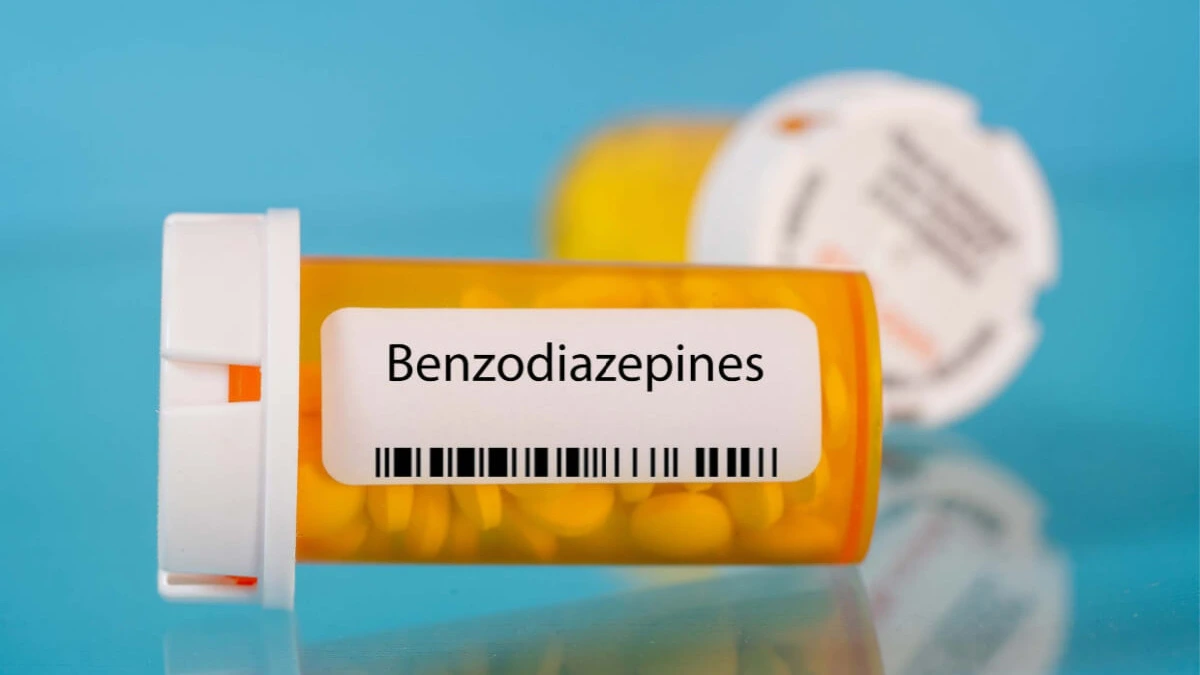Benzodiazepines: Types and Medical Uses
Benzodiazepines, a class of psychoactive drugs, have revolutionized the field of mental health treatment. With a diverse range of compounds, this pharmaceutical family addresses an array of conditions, from anxiety disorders to insomnia and seizures.
Despite their therapeutic benefits, benzodiazepines also raise concerns due to potential dependence and misuse.
Exploring the nuanced landscape of benzodiazepines unveils a multifaceted approach to mental health, balancing benefits and risks for optimal patient care.

Key Takeaways
Benzodiazepines can be habit-forming, and tolerance can develop with regular use. Here’s what you need to know:
- Benzodiazepines, such as diazepam and alprazolam, are a class of psychoactive drugs commonly used to treat anxiety, insomnia, and seizures.
- Short-acting benzodiazepines like lorazepam provide acute anxiety relief, while long-acting ones like clonazepam offer sustained control but may lead to dependence.
- Benzodiazepines carry the risk of tolerance, dependence, and withdrawal, emphasizing the importance of cautious use and medical supervision.
Contact The Haven Detox-Little Rock (501) 271-3342 for more information and medical help to embrace a drug-free life.
Benzodiazepines: An Overview
Benzodiazepines, commonly known as “benzos,” are calming to the central nervous system. These medications are widely prescribed to treat a range of conditions, including anxiety, insomnia, seizures, and muscle spasms.
The therapeutic effects of benzos are attributed to their ability to enhance the activity of gamma-aminobutyric acid (GABA), a neurotransmitter that inhibits brain activity.
By modulating GABA receptors, benzodiazepines induce a sedative and anxiolytic (anxiety-reducing) effect, making them valuable tools in managing various medical conditions.
Brief History Benzodiazepines
The history of benzodiazepines dates back to the mid-20th century when chemists Leo Sternbach and Earl Reeder synthesized chlordiazepoxide, the first benzodiazepine, in 1955. This discovery revolutionized the field of psychopharmacology, leading to the development of numerous benzodiazepine derivatives with varying properties.
Diazepam, marketed as Valium, gained widespread popularity in the 1960s and 1970s, becoming one of the most prescribed medications globally. Over the years, other benzodiazepines, such as alprazolam (Xanax) and lorazepam (Ativan), emerged and found their place in medical practice.
Dosage and Use of Benzos
Benzodiazepines are available in various formulations, including tablets, capsules, and liquid forms, with dosage recommendations tailored to the treated condition. The appropriate dosage depends on factors such as the patient’s age, medical history, and the severity of the condition.
These medications are prescribed for short-term use due to the risk of developing tolerance, dependence, and experiencing withdrawal symptoms. Common therapeutic uses include:
- Alleviating acute anxiety.
- Promoting sleep in insomnia.
- Managing seizures.
- Providing preoperative sedation.
Healthcare professionals should carefully assess patients and monitor their response to benzodiazepine therapy to minimize potential side effects and ensure optimal treatment outcomes.
Long-Acting Benzodiazepines
Long-acting benzodiazepines are a subgroup of benzodiazepines with a prolonged duration of action. They typically have a slower onset of action, a longer duration of effect, and a slower elimination from the body compared to short-acting benzodiazepines.
This characteristic can be beneficial in certain medical situations, such as the treatment of chronic anxiety or certain sleep disorders, as it allows for less frequent dosing.
Some examples of long-acting benzodiazepines include:
Diazepam
Diazepam, commonly known by its brand name Valium, is a prototypical long-acting benzodiazepine. Its extended duration of action is attributed to its active metabolites, leading to a sustained anxiolytic effect.
Diazepam is often prescribed for the management of generalized anxiety disorders, panic attacks, and muscle spasms. Its gradual onset and prolonged duration make it suitable for chronic conditions requiring continuous symptom control.
Clonazepam
Clonazepam, marketed as Klonopin, is another long-acting benzodiazepine known for its anticonvulsant and anxiolytic properties. Due to its longer half-life, clonazepam is effective in preventing the recurrence of seizures and managing panic disorder.
Its sustained action allows for less frequent dosing, improving patient compliance. However, the prolonged presence of the drug in the system can increase the risk of accumulation and side effects.
Immediate-Acting Benzodiazepines
Immediate-acting benzodiazepines have a rapid onset of action and a relatively short duration of effect. These medications are often prescribed for conditions where quick relief of symptoms, such as anxiety or acute panic attacks, is required.
Due to their rapid onset, they are suitable for as-needed or short-term use. It’s important to note that these medications also carry the risk of dependence and should be used under the supervision of a healthcare professional.
Here are some examples of immediate-acting benzodiazepines:
Lorazepam
Lorazepam, available under the brand name Ativan, is an immediate-acting benzodiazepine commonly used for the short-term relief of anxiety symptoms. Its rapid onset of action and intermediate duration make it suitable for acute situations, such as panic attacks and agitation.
Lorazepam is also employed in medical settings for preoperative sedation and the management of alcohol withdrawal symptoms.
Alprazolam
Alprazolam, marketed as Xanax, is another immediate-acting benzodiazepine notable for its quick onset of action. It is often prescribed for the short-term treatment of anxiety disorders and panic attacks. However, the rapid elimination of alprazolam from the body can lead to a higher potential for withdrawal symptoms between doses.
This characteristic necessitates careful monitoring and adjustment of dosage to prevent dependency and risk of addiction.
Short-Acting Benzodiazepines
Short-acting benzodiazepines have a relatively rapid onset of action and a shorter duration of effect compared to other benzodiazepines. These medications are often prescribed for conditions where quick relief of symptoms is needed, such as in the case of acute anxiety or insomnia.
Short-acting benzodiazepines are generally used on an as-needed basis rather than as a daily, ongoing treatment. It’s important to note that they still carry the risk of dependence and should be used under the guidance of a healthcare professional.
Examples of short-acting benzodiazepines include:
Triazolam
Triazolam, sold under the brand name Halcion, is a short-acting benzodiazepine primarily used for the management of insomnia. Its rapid onset and short duration of action make it suitable for inducing sleep, but it may not be ideal for maintaining sleep throughout the night.
Triazolam is generally prescribed for short-term use due to concerns about dependence and rebound insomnia.
Safety of Benzodiazepines
Benzodiazepines can be effective in managing certain medical issues, but it’s important to be aware of their safety considerations, including the risks of addiction and overdose.
Let’s have a look at concerns related to benzodiazepine use:
Addiction Risk
Benzodiazepines have the potential for abuse and addiction, especially when used for an extended period. Tolerance to the therapeutic effects can develop, leading people to take higher doses over time to achieve the same results.
Abrupt discontinuation of benzodiazepines after prolonged use can result in withdrawal symptoms, which can be uncomfortable and, in severe cases, may even be life-threatening.
Healthcare providers must monitor patients using benzodiazepines carefully. Patients should follow their healthcare provider’s instructions closely, and any concerns about dependence or withdrawal should be discussed with a healthcare professional.
Overdose Risk
The risk of overdose with benzodiazepines is generally low when they are taken as prescribed. However, the risk increases when they are misused, especially when combined with other substances that depress the central nervous system, such as alcohol or opioids.
Overdose symptoms may include extreme drowsiness, confusion, impaired coordination, and, in severe cases, respiratory depression, which can be life-threatening.
It is advised to use benzodiazepines only as directed by a healthcare professional and to avoid combining them with other substances that can enhance their sedative effects. In case of a suspected overdose, emergency medical attention should be sought immediately.
Long-Term Use Concerns
Long-term use of benzodiazepines can raise concerns about cognitive impairment, especially in older adults. Additionally, there is evidence suggesting that long-term use may be associated with an increased risk of falls and fractures in older people.
Healthcare providers should regularly reassess the need for benzodiazepine therapy, considering alternative treatments or gradual tapering when appropriate. Patients should communicate any concerns or changes in their health to their healthcare provider.
Frequently Asked Questions (FAQ)
What are benzos?
Benzodiazepines, commonly known as benzos, are a class of drugs that exert a calming effect on the central nervous system. Prescribed for anxiety, insomnia, and seizures, they enhance the action of a neurotransmitter called gamma-aminobutyric acid (GABA).
Intermittent use and higher doses in young adults can lead to dependence and benzodiazepine withdrawal, necessitating cautious and monitored medical attention from doctors.
What are the different types of benzodiazepines and their primary uses?
Benzodiazepines, a class of central nervous system depressants, alleviate symptoms of anxiety. Common types include diazepam and lorazepam. The American Psychiatric Association warns that a daily dose of street benzos can lead to respiratory depression, abuse, overdose, and addiction problems.
What are the differences between all benzodiazepines?
Benzodiazepine drugs vary in potency, onset, duration, and specific therapeutic uses. For example, diazepam lasts longer, while alprazolam has a shorter onset. Clonazepam is used for seizures, and lorazepam is used for rapid relief of anxiety.
Individual responses and adverse effects can differ, influencing the choice of benzodiazepine based on the patient’s condition and medical history.
Rise Above Addiction: Choose The Haven Detox-Little Rock
Step into a life of liberation with The Haven Detox-Little Rock, where hope blossoms and recovery becomes a reality.
Our comprehensive addiction treatment services guide you toward a healthier, substance-free life. Our specialized detox and residential treatment programs are tailored to break the addiction cycle, providing a supportive environment for healing.
Our expert therapists empower you with the tools and support for lasting recovery.
Your journey to wellness begins here. Call us at (501) 271-3342 today for more information.





